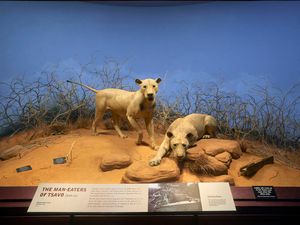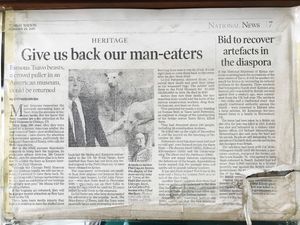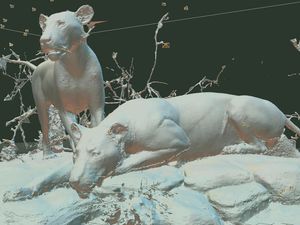Simba Mbili
Ongoing
Simba Mbili_01_Field Museum Display_Courtesy J. Weinstein_(c)Field Museum_2016
"for As-yet-unknown Uses"(1): Potential Histories And Futures Of The Man-eaters Of Tsavo - Sam Hopkins And Marian Nur Goni
original publicationTypically, the story is told like this:
In 1898, when the British were building the Uganda Railway to connect the port of Mombasa with Lake Victoria–a major imperial infrastructure between present-day Kenya and Uganda–they encountered two man-eating lions in a territory known as Tsavo. These lions terrorised the African labourers and the Indian indentured workers building the railway, killing dozens of individuals and bringing the construction to halt (2). The engineer responsible for building the bridge over the Tsavo river, Colonel John Henry Patterson, eventually killed the lions in late 1898. Their death was announced in the House of Lords in London and the lions were immortalised in Patterson's book The Man-eaters of Tsavo and other East-African adventures (1907), praised by US President Roosevelt as “the most remarkable account of which we have any record.”(3)
In 1924, the Field Museum of Chicago bought the lion skins (and their skulls), which Patterson had been using in his home as rugs, for 5000 dollars.(4) Julius Friesser, a taxidermist working at the museum, then transformed these rugs into taxidermied specimens. They were placed in a diorama, where they still reside today.
The above is one version of the events, and it has been repeatedly reproduced in popular culture for more than a century. Stemming from The Man-Eaters of Tsavo’s master narrative, it aggregates a “family of films,” directly or more-loosely connected to it, which position/envision Africa as “this place where you collect memories” as one character of The Killers of Kilimanjaro (1959) aptly puts it: i.e. a playground for manly experiences testing out Western masculinities.
The first Hollywood adaptation of the story, Bwana Devil, an adventure B-movie–which happens to have entered cinema history for being the first 3D film in color with sound–was released in 1952. Interestingly this is the same year in which a major, political uprising, widely known as Mau Mau, began in Kenya.(5) The colonial regime declared a State of Emergency which was to last for 8 years leading eventually to Kenya's independence in 1963. These social and political movements are illegible in the films which depict (colonial) business as usual.

Simba Mbili_01_Field Museum Display_Courtesy J. Weinstein_(c)Field Museum_2016
Our attention has been captured by these seemingly coincidental disjunctions. Indeed, in the course of our research, we have come across a number of other narratives invisibilized by the dominant version. Often, these discrepancies have opened entirely new spaces of inquiry and questions in which the white male hunter is no longer centerstage battling to dominate the African “wild” nature. A number of other actors–including non human actors such as the lions themselves(6)– emerge which involve altogether a different set of gestures and vocabularies: these speak of claims, of rights, of working conditions, of resistance.(7) We have been intrigued by the amount of energies, investments, emotions, gestures, languages that these two lions continue to trigger in very different (geopolitical) spaces more than a century after their demise. Furthermore, we have realized that we too have been moved by them in a variety of ways and have now come to see ourselves as agents involved in their manifold, transnational trajectories, and the questions they raise, which we try to intertwine.
Between 2018 and 2022, we have been involved in an project entitled the International Inventories Programme, which brought together researchers, museum professionals and two artists' collectives, The Nest and SHIFT, between Kenya and Germany, with the aim of building a database of Kenyan objects held outside of Kenya. The project is part of a global, decolonial discussion about restitution and the ownership of cultural heritage in the aftermath of imperialism. Over the three years of the project, we built up an (ongoing) database of over 32,000 objects from the inventories of thirty museums in seven countries.(8) It is then in this frame–restitution–that we first came across both Kenyan and British articles about diplomatic gestures, or talks, that took place in the mid-2000s to try and repatriate the two lions to Kenya.
In the Railway Museum in Nairobi, we found a faded photocopy of a newspaper article from 2007 titled “Give us back our man-eaters”.(9) This is a museum that, arguably, would be in a good position to tell this story or even to possibly house the lions themselves. We are interested in trying to understand what both the presence (in the US) and the absence (in Kenya) of these lions produces. Seen from this perspective, a number of politicians, scientists, activists, regular groups of citizens both in the US and Kenya enter the scene.(10) Some of them link the animal decimation in the 19th century to the current loss of biodiversity, or to current human-“wildlife” conflicts, attesting to “how objects collect people, that is how museum objects to some degree conceal the mass of relations that lie behind them (...)”(11)

Simba Mbili_02_Nairobi Railway Museum Display_(c)Hopkins and Nur Goni
We struggle to find a word that embraces the multiplicity of statuses that these lions have, and have had, in their century-old lives. Indeed, because of their previous afterlives as rugs, pieces of other lion skins were needed to turn them into museum specimens.We have become interested by those who call for a specific status of the specimens in natural history museums.(12) In the case of these two lions, their status becomes even more complex with the recent discovery of hundreds of human hairs which were hidden within the cavity of the lions’ teeth from the dozen laborers killed in 1898.(13) Analysis such as this DNA testing further complicates not only what we might think the lions are, but what they might become, in a future of potentially endless data extraction. On another level, we wonder, whether their potential becoming might perhaps also include in the future their possible return?

Simba Mbili_03_Digital Render_(c)Schoenewolf Hopkins and Nur Goni
--
- Part of which is online, see: https://www.inventoriesprogramme.org/explore.
- Cited in The Man-eaters of Tsavo and other East-African adventures (1907).
- Recent studies have brought these figures to approximately 35 persons while in his book, J.H. Patterson evoked the number of 135 railway workers.
- This sum corresponds to about 100.000 dollars by today’s standards.
- See BBC, “Kenya wants Tsavo man-eaters back”, September 11, 2007, or more recently (December 5, 2023), Lucy Mkanyika, “Man eaters of Tsavo: Bring back the lions, Taita Taveta tells US Chicago museum”, The Nation.
- See the sound piece we presented in the frame of the International Inventories Programme exhibition, based on a vox populi conducted by Junniah Wamaitha in downtown Nairobi in 2021.
- See, for instance in France, the works by Violette Pouillard (2019, 2022) or Eric Baratay (2017, 2019).
- Such as long-term Paris Natural history museum taxidermist, Jack Thinay, who pleads for a specific status, cited in Lucienne Strivay, “Taxidermies. Le trouble du vivant”, Anthropologie et Sociétés, vol. 39, no 1-2, 2015, pp. 259.
- Although commonly known as Mau Mau, the resistance force was actually called the Land and Freedom Army. The British regime responded with brutal force, building concentration camps, and torturing suspected members of the movement. In 2013 the British government issued an official apology and paid compensation for these atrocities.
- Chris Gosden, Frances Larson and Alison Petch, Knowing Things: Exploring the Collections at the Pitt Rivers Museum, 1884-1945. Oxford, Oxford University Press, 2007, cited in Adrian Van Allen, “Bird Skin to Biorepository: Making Materials Matter in the Afterlives of Natural History Collections”, op. cit., p. 539.
- Excerpt from Adrian Van Allen, “Bird Skin to Biorepository: Making Materials Matter in the Afterlives of Natural History Collections”, Knowledge Organization, vol. 44, no. 7, 2017, p. 532.
- For instance, our historian colleague Taushif Kara generously drew our attention to the fact that the “lions incident” prompted a discussion in the Indian press about the working conditions of the Indian laborers abroad, which we are currently enquiring into.
- See Julian C. Kerbis Peterhans and Thomas Patrick Gnoske, “The Science of ‘Man-Eating’ Among Lions Panthera leo With a Reconstruction of the Natural History of the ‘Man-Eaters of Tsavo’”, Journal of East African Natural History, 90(1):1-40. 2001.